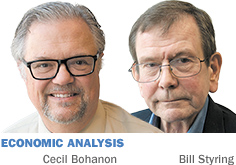Subscriber Benefit
As a subscriber you can listen to articles at work, in the car, or while you work out. Subscribe Now
 Federal Reserve officials speak a jargon-laced foreign tongue nicknamed “Fedspeak.”
Federal Reserve officials speak a jargon-laced foreign tongue nicknamed “Fedspeak.”
Opaqueness has advantages. Explained in everyday English, one consequence of recent Fed policy would be embarrassing. “We are giving banks $12.25 billion a year in free profits for doing absolutely nothing. Moreover, for every 1 percent we jack up the federal funds rate in the future, that effortless gain goes up another $25 billion.”
In Fedspeak, the game is called “interest on excess reserves” (IOER). Banks have to maintain a certain balance in an account with the Fed as backing for their own deposits. Anything above the required minimum is “excess reserves.” From its inception in 1913 until 2008, the Fed paid no interest on ERs. Naturally, banks didn’t like to hold ERs; they earned nothing. In mid-2008, the banking system as a whole had $44 billion in required reserves and a measly $1.4 billion of ERs.
Tucked away in the massive 2008 TARP bailout bill was a little provision allowing the Fed, for the first time, to pay interest on ERs. No big deal, right? ERs are basically zilch, right?
But then along came “quantitative easing.” The Fed bought outright some $4 trillion in bonds, $2.5 trillion of which were Treasury bonds. When the Fed buys a Treasury, the amount winds up as some bank’s excess reserves. (We don’t have space to detail how this happens. Trust us; it does.) Banks do nothing except process checks just as they always do. But presto! They magically now have $2.5 trillion in ERs on which they are being paid 0.5 percent interest: $2.5 trillion times 0.5 percent equals $12.25 billion in IOER for which banks have done nothing.
Where did the 0.5 percent interest rate come from? The Fed doesn’t want to unleash $2.5 trillion of newly printed money on the economy. Very Bad Things would happen. So, it has to bribe banks to keep those new ERs safely tucked away at the Fed. Keep the IOER just above what the banks could make lending them out (the “federal funds rate”). As the FFR goes up in the future, as the Fed plans, so will IOER.
Confused? Let’s hope the politicians stay that way, too. If they find out and get outraged, they could well figure out a way to make things worse!•
__________
Bohanon is a professor of economics at Ball State University. Styring is an economist and independent researcher. Both also blog at INforefront.com. Send comments to ibjedit@ibj.com.
Please enable JavaScript to view this content.
